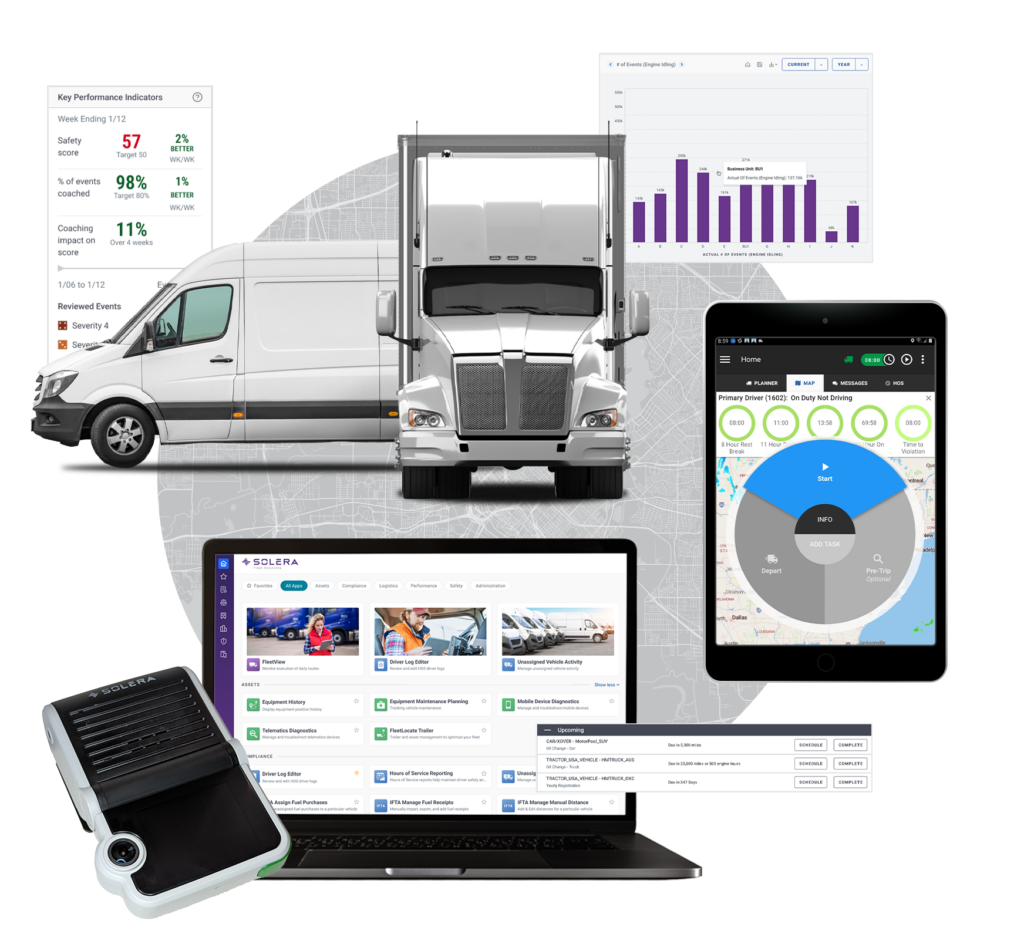Fleet analytics refers to the use of data from the sensors and cameras in your vehicles to examine multiple data points of fleet performance to draw insights for data-backed decision-making and optimizing fleet operations.
Smart IQ collects and analyzes massive amounts of data on every aspect of fleet activity to provide insights on how to improve fleet efficiency, safety, and financial performance.
Solera Insight impacts Every element of fleet operations — drivers, vehicles, routing, and process — is connected. By using data to analyze and understand those relationships, Insight helps you make more informed fleet decisions.
Solera Predictive Analytics uses AI and machine learning to identify patterns in telematics data, allowing you to identify drivers at risk of leaving, mitigate future accidents, and control costs.
IntelliScan lets you asses a trailer’s load status with 99% accuracy. With the Percent Full and Percent Available readings it provides, you can move more cargo and increase backhaul opportunities.
Virtual Load View lets you and your customers track the location of their shipments with a simple tracking request that generates automated updates and alerts. Complete data flow control keeps fleet and customer data safe.
The Performer Series includes Safety Performer to manage safety events; CSA Performer to monitor violations, Retention Performer, to coach at-risk drivers, and Driver Performer, which collects consolidates driver metric in a single platform.
See how a Solera case study goes here.
Here is the text for Downloadable Asset Number One. Here is the text for Asset One
Operational efficiency encompasses several critical aspects of fleet management. Fleet performance analytics help improve efficiency by providing data-driven insights across these areas, allowing for smarter, more informed decision-making. There are several areas where analytics can make a significant difference in fleet performance:
With fleet performance analytics, you gain a clearer picture of how your operations are running and where you can make improvements. These insights help you address inefficiencies, make smarter decisions, and ensure your fleet operates at its full potential. By transforming raw data into tangible insights, fleet performance analytics empower you to stay agile and make decisions that improve fleet productivity and increase revenue over time.
Tracking the right metrics is critical to understanding how your fleet is performing and where improvements can be made. These metrics can generally be broken down into three key categories:
By focusing on these types of metrics, you gain a comprehensive view of your fleet’s performance so you can make data-driven decisions to increase efficiency, reduce costs, and improve safety.
Fleet vehicles that are equipped with sensors, dash-cams, and telematics devices can collect valuable data for analysis. Here are some examples of data that can be collected:
By collecting and analyzing this data, fleet managers can make smarter decisions to improve efficiency, reduce costs, and enhance safety.
Predictive analytics use data, AI, and machine learning to forecast future events, allowing fleet managers to take proactive steps. In the context of fleet maintenance, predictive analytics identify patterns in vehicle performance and wear, helping you spot issues before they cause dangerous and expensive breakdowns.
Analyzing data like engine diagnostics and vehicle usage allows predictive models to recommend scheduled maintenance, reducing unexpected downtime. This proactive approach ensures vehicles are in optimal condition and helps extend their lifespan, leading to lower operational costs and better fleet performance
Data security is a top priority for fleet management. The data collected from fleet vehicles, including telematics and driver behavior, is protected through advanced encryption and secure cloud storage. Solera’s solutions ensure that only authorized users have access to sensitive data, and regular security updates help keep your system safe from threats. Compliance with industry standards and data privacy regulations also ensures that both fleet and customer information is constantly protected. With these measures in place, you can confidently use fleet analytics without worrying about data breaches or unauthorized access.
Solera has brought together the most experienced companies in fleet management to provide a seamless, end-to-end platform that simplifies and improves operations for every type of fleet.

"*" indicates required fields